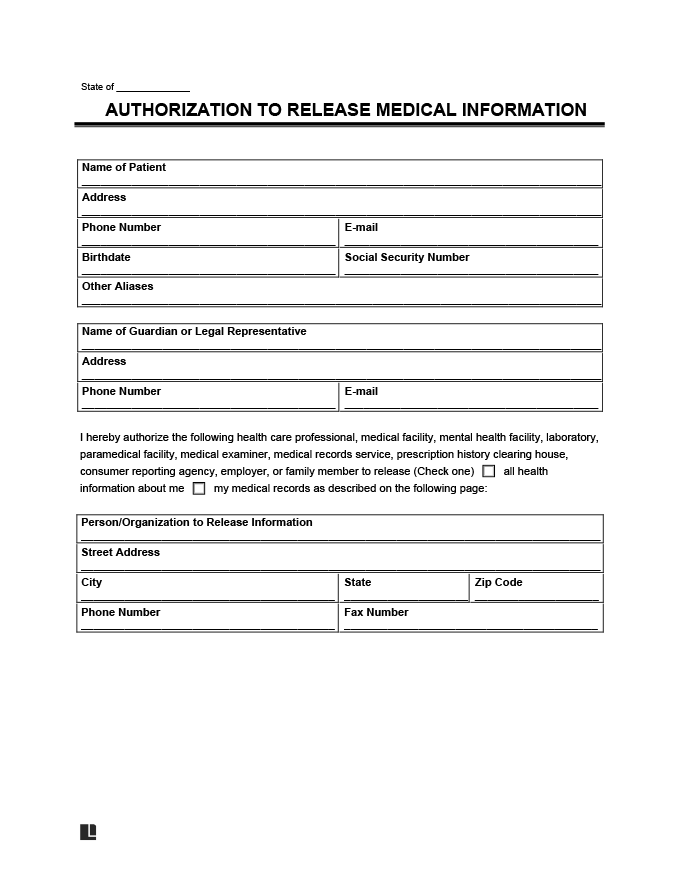What Is a Medical Records Release Form?
A medical records release form gives you control over who can access your protected health information (PHI). It’s required under the Health Insurance Portability and Accountability Act (HIPAA), a US federal law that protects your privacy and sets rules for how providers share medical records. When you make a request, the provider will send only what’s already in the file, which usually includes:
- Doctor’s notes
- Lab results and test reports
- Imaging, like X-rays or MRIs
- Billing and insurance details
Some records are off limits. A medical records release form won’t include:
- Private psychotherapy notes
- Documents prepared for legal cases
Sharing without proper consent could lead to a breach of confidentiality. That’s why providers follow strict HIPAA rules when releasing information. They’ll also let you choose how the records are sent, by mail, email, or another secure method.
The CDC reports that 88% of doctors use electronic systems for medical records, with 78% using certified systems. Access is improving, too. In 2024, 77% of patients had online access, and 34% used their patient portal six or more times—twice the rate in 2019. With more digital records, it’s easier to access them by email, secure portal, or download.
When Should You Complete a Medical Records Release Form?
A medical records release form lets you request your health information or share it with someone else. If you’re helping another person as their legal guardian or representative, you can use the form for them too. People often use it to:
- Get records from a provider or health plan
- Send information to a doctor or specialist
- Give access to a caregiver or family member
- Share details for legal, insurance, or personal reasons
Keep in mind that providers and health plans can ask you to fill out a form, but only if it doesn’t slow things down or make it harder to get your records. And they typically accept forms by email, through a secure web portal, or by mail. That level of access is important to most people. Eight in ten Americans say having access to their medical records is important or very important.
Access Can Improve Care
- Electronic records help improve care quality and reduce errors (PubMed Central).
- Patients are more likely to follow treatment plans when they can view their records (JMIR).
- People with diabetes improved their blood sugar control by checking their records regularly (BMJ).
When Is a Medical Records Release Form Not Required?
You don’t always need a medical records release form. In some cases, providers can share your health information without one. That includes situations like:
- When you ask for your records for yourself
- When the information is used for treatment or billing
- When it’s needed for healthcare operations, such as audits
- If there’s a court order or legal requirement, such as a law enforcement investigation
- For public health or safety reasons
- For workers’ compensation claims
- In some research, if privacy protections are in place
Outside of these cases, most situations still require a signed form.
How Do You Write an Authorization Letter for Medical Records Release?
Providers won’t release records without proper authorization. Here’s how to write a letter that gives them everything they need to move it forward.
1. Add the Patients Key Information
Start by entering the patient’s full name, date of birth, social security number, contact details, and full street address, including the city, state, and ZIP code. This information helps the provider match the request to the correct file and confirm the patient’s identity.
2. Say Who’s Making the Request
Let the provider know if you’re filling out the form for yourself or for someone else. If you’re a legal guardian, parent, or hold power of attorney, include your name, your role, and how you’re authorized to act on the patient’s behalf. Provide copies of any documents giving you authorization to complete the request.
If you’re authorizing the release of someone else’s PHI, you may be acting under a medical power of attorney or a minor power of attorney. In this case, you should identify yourself as the patient’s guardian or legal representative on the authorization form
3. Explain Why You’re Requesting the Records
Briefly mention the reason for the request so the provider knows how to process it. Common reasons include:
- Follow-up care or treatment
- Getting a second opinion
- Filing an insurance claim
- Handling a legal matter
4. List the Records You Need
Be specific about what you’re asking for. You can request:
- All medical records
- Records from a certain facility, such as a primary care doctor’s office or a specific hospital
- Certain types of documents, like test results, imaging, or billing details
- Records from a specific time period
5. Flag Any Sensitive Information
If the request includes details about mental health treatment, substance use, or HIV status, make sure to clearly state that. You’ll need to give extra permission to release this type of information.
6. Say Who’s Sending and Receiving the Records
Start by naming the provider or facility that holds the records. Then, include the name and contact details of the person or organization you want to receive them. This might be a new doctor, an insurance company, or even yourself. Clear information helps avoid delays.
7. Add Final Details and Sign
Next, include when the authorization should begin and how long it should last—90 days, one year, or whatever fits your situation. Some forms will expire within a set time if no expiration date is included. To finish, the patient or their legal representative needs to sign the form. Without a signature, the provider can’t release the records.
Medical Records Release Form Sample
Take a look at a completed medical records release form template before filling out your own. You can download it as a PDF or Word document.







